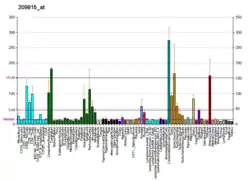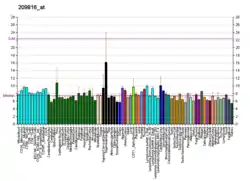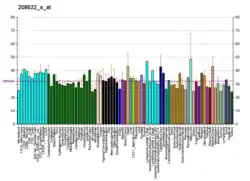PTCH1
Protein patched homolog 1 is a protein that is the member of the patched family and in humans is encoded by the PTCH1 gene.[5][6]
Function
PTCH1 is a member of the patched gene family and is the receptor for sonic hedgehog, a secreted molecule implicated in the formation of embryonic structures and in tumorigenesis. This gene functions as a tumor suppressor. The PTCH1 gene product, is a transmembrane protein that suppresses the release of another protein called smoothened, and when sonic hedgehog binds PTCH1, smoothened is released and signals cell proliferation.
Clinical significance
Mutations of this gene have been associated with nevoid basal cell carcinoma syndrome (AKA Gorlin's Syndrome),[7] esophageal squamous cell carcinoma, trichoepitheliomas, transitional cell carcinomas of the bladder, as well as holoprosencephaly. Alternative splicing results in multiple transcript variants encoding different isoforms. Additional splice variants have been described, but their full length sequences and biological validity cannot be determined currently.[6]
Mutations in PTCH1 cause Gorlin syndrome and mutations have also been found in holoprosencephaly patients.[8][9][10] Some of these patients present cleft lip and palate among the holoprosencephaly features, and missense variants in PTCH1 were also found in a sequencing screening of nonsyndromic cleft lip and palate patients.[11] In addition association between SNPs in or near PTCH1 have been found to be associated with nonsyndromic cleft lip and palate.[11][12] Mutations in PTCH1 are also associated with medulloblastoma.[13]
References
- GRCh38: Ensembl release 89: ENSG00000185920 - Ensembl, May 2017
- GRCm38: Ensembl release 89: ENSMUSG00000021466 - Ensembl, May 2017
- "Human PubMed Reference:". National Center for Biotechnology Information, U.S. National Library of Medicine.
- "Mouse PubMed Reference:". National Center for Biotechnology Information, U.S. National Library of Medicine.
- Johnson RL, Rothman AL, Xie J, Goodrich LV, Bare JW, Bonifas JM, Quinn AG, Myers RM, Cox DR, Epstein EH, Scott MP (Aug 1996). "Human homolog of patched, a candidate gene for the basal cell nevus syndrome". Science. 272 (5268): 1668–71. doi:10.1126/science.272.5268.1668. PMID 8658145. S2CID 9160210.
- "Entrez Gene: PTCH1 patched homolog 1 (Drosophila)".
- Cantú-Reyna, Consuelo (2014). "Mutation in the PTCH1 tumor suppressor gene in gorlin syndrome. A case report". Acta Pediatr Esp. 72 (11): e407–e414. Retrieved 12 March 2019.
- Ming JE, Kaupas ME, Roessler E, Brunner HG, Golabi M, Tekin M, Stratton RF, Sujansky E, Bale SJ, Muenke M (April 2002). "Mutations in PATCHED-1, the receptor for SONIC HEDGEHOG, are associated with holoprosencephaly". Hum. Genet. 110 (4): 297–301. doi:10.1007/s00439-002-0695-5. PMID 11941477. S2CID 32865658.
- Rahimov F, Ribeiro LA, de Miranda E, Richieri-Costa A, Murray JC (December 2006). "GLI2 mutations in four Brazilian patients: how wide is the phenotypic spectrum?". Am. J. Med. Genet. A. 140 (23): 2571–6. doi:10.1002/ajmg.a.31370. PMID 17096318. S2CID 21019963.
- Ribeiro LA, Quiezi RG, Nascimento A, Bertolacini CP, Richieri-Costa A (July 2010). "Holoprosencephaly and holoprosencephaly-like phenotype and GAS1 DNA sequence changes: Report of four Brazilian patients". Am. J. Med. Genet. A. 152A (7): 1688–94. doi:10.1002/ajmg.a.33466. PMID 20583177. S2CID 25445281.
- Mansilla MA, Cooper ME, Goldstein T, Castilla EE, Lopez Camelo JS, Marazita ML, Murray JC (January 2006). "Contributions of PTCH gene variants to isolated cleft lip and palate". Cleft Palate Craniofac. J. 43 (1): 21–9. doi:10.1597/04-169R.1. PMC 2151847. PMID 16405370.
- Moreno LM, Mansilla MA, Bullard SA, Cooper ME, Busch TD, Machida J, Johnson MK, Brauer D, Krahn K, Daack-Hirsch S, L'heureux J, Valencia-Ramirez C, Rivera D, López AM, Moreno MA, Hing A, Lammer EJ, Jones M, Christensen K, Lie RT, Jugessur A, Wilcox AJ, Chines P, Pugh E, Doheny K, Arcos-Burgos M, Marazita ML, Murray JC, Lidral AC (December 2009). "FOXE1 association with both isolated cleft lip with or without cleft palate, and isolated cleft palate". Hum. Mol. Genet. 18 (24): 4879–96. doi:10.1093/hmg/ddp444. PMC 2778374. PMID 19779022.
- Jones DT, Jäger N, Kool M, Zichner T, Hutter B, Sultan M, Cho YJ, Pugh TJ, Hovestadt V, Stütz AM, Rausch T, Warnatz HJ, Ryzhova M, Bender S, Sturm D, Pleier S, Cin H, Pfaff E, Sieber L, Wittmann A, Remke M, Witt H, Hutter S, Tzaridis T, Weischenfeldt J, Raeder B, Avci M, Amstislavskiy V, Zapatka M, Weber UD, Wang Q, Lasitschka B, Bartholomae CC, Schmidt M, von Kalle C, Ast V, Lawerenz C, Eils J, Kabbe R, Benes V, van Sluis P, Koster J, Volckmann R, Shih D, Betts MJ, Russell RB, Coco S, Tonini GP, Schüller U, Hans V, Graf N, Kim YJ, Monoranu C, Roggendorf W, Unterberg A, Herold-Mende C, Milde T, Kulozik AE, von Deimling A, Witt O, Maass E, Rössler J, Ebinger M, Schuhmann MU, Frühwald MC, Hasselblatt M, Jabado N, Rutkowski S, von Bueren AO, Williamson D, Clifford SC, McCabe MG, Collins VP, Wolf S, Wiemann S, Lehrach H, Brors B, Scheurlen W, Felsberg J, Reifenberger G, Northcott PA, Taylor MD, Meyerson M, Pomeroy SL, Yaspo ML, Korbel JO, Korshunov A, Eils R, Pfister SM, Lichter P (August 2012). "Dissecting the genomic complexity underlying medulloblastoma". Nature. 488 (7409): 100–5. doi:10.1038/nature11284. PMC 3662966. PMID 22832583.
Further reading
- Villavicencio EH, Walterhouse DO, Iannaccone PM (2000). "The sonic hedgehog-patched-gli pathway in human development and disease". Am. J. Hum. Genet. 67 (5): 1047–54. doi:10.1016/S0002-9297(07)62934-6. PMC 1288546. PMID 11001584.
- Corcoran RB, Scott MP (2002). "A mouse model for medulloblastoma and basal cell nevus syndrome". J. Neurooncol. 53 (3): 307–18. doi:10.1023/A:1012260318979. PMID 11718263. S2CID 12886219.
- Lindström E, Shimokawa T, Toftgård R, Zaphiropoulos PG (2006). "PTCH mutations: distribution and analyses". Hum. Mutat. 27 (3): 215–9. doi:10.1002/humu.20296. PMID 16419085. S2CID 35694533.
- Gailani MR, Bale SJ, Leffell DJ, et al. (1992). "Developmental defects in Gorlin syndrome related to a putative tumor suppressor gene on chromosome 9". Cell. 69 (1): 111–7. doi:10.1016/0092-8674(92)90122-S. PMID 1348213. S2CID 25784843.
- Hahn H, Christiansen J, Wicking C, et al. (1996). "A mammalian patched homolog is expressed in target tissues of sonic hedgehog and maps to a region associated with developmental abnormalities". J. Biol. Chem. 271 (21): 12125–8. doi:10.1074/jbc.271.18.10941. PMID 8647801.
- Hahn H, Wicking C, Zaphiropoulous PG, et al. (1996). "Mutations of the human homolog of Drosophila patched in the nevoid basal cell carcinoma syndrome". Cell. 85 (6): 841–51. doi:10.1016/S0092-8674(00)81268-4. PMID 8681379. S2CID 16281524.
- Gailani MR, Ståhle-Bäckdahl M, Leffell DJ, et al. (1996). "The role of the human homologue of Drosophila patched in sporadic basal cell carcinomas". Nat. Genet. 14 (1): 78–81. doi:10.1038/ng0996-78. PMID 8782823. S2CID 5221628.
- Chidambaram A, Goldstein AM, Gailani MR, et al. (1996). "Mutations in the human homologue of the Drosophila patched gene in Caucasian and African-American nevoid basal cell carcinoma syndrome patients". Cancer Res. 56 (20): 4599–601. PMID 8840969.
- Bonaldo MF, Lennon G, Soares MB (1997). "Normalization and subtraction: two approaches to facilitate gene discovery". Genome Res. 6 (9): 791–806. doi:10.1101/gr.6.9.791. PMID 8889548.
- Stone DM, Hynes M, Armanini M, et al. (1996). "The tumour-suppressor gene patched encodes a candidate receptor for Sonic hedgehog". Nature. 384 (6605): 129–34. doi:10.1038/384129a0. PMID 8906787. S2CID 4342540.
- Wicking C, Shanley S, Smyth I, et al. (1997). "Most germ-line mutations in the nevoid basal cell carcinoma syndrome lead to a premature termination of the PATCHED protein, and no genotype-phenotype correlations are evident". Am. J. Hum. Genet. 60 (1): 21–6. PMC 1712561. PMID 8981943.
- Lench NJ, Telford EA, High AS, et al. (1997). "Characterisation of human patched germ line mutations in naevoid basal cell carcinoma syndrome". Hum. Genet. 100 (5–6): 497–502. doi:10.1007/s004390050541. PMID 9341860. S2CID 944397.
- Aszterbaum M, Rothman A, Johnson RL, et al. (1998). "Identification of mutations in the human PATCHED gene in sporadic basal cell carcinomas and in patients with the basal cell nevus syndrome". J. Invest. Dermatol. 110 (6): 885–8. doi:10.1046/j.1523-1747.1998.00222.x. PMID 9620294.
- Carpenter D, Stone DM, Brush J, et al. (1998). "Characterization of two patched receptors for the vertebrate hedgehog protein family". Proc. Natl. Acad. Sci. U.S.A. 95 (23): 13630–4. doi:10.1073/pnas.95.23.13630. PMC 24870. PMID 9811851.
- Liu JH, Wei S, Burnette PK, et al. (1999). "Functional association of TGF-beta receptor II with cyclin B." Oncogene. 18 (1): 269–75. doi:10.1038/sj.onc.1202263. PMID 9926943.
- Hasenpusch-Theil K, Bataille V, Laehdetie J, et al. (1999). "Gorlin syndrome: identification of 4 novel germ-line mutations of the human patched (PTCH) gene. Mutations in brief no. 137. Online". Hum. Mutat. 11 (6): 480. doi:10.1002/(SICI)1098-1004(1998)11:6<480::AID-HUMU9>3.0.CO;2-4. PMID 10200051.
- Dong J, Gailani MR, Pomeroy SL, et al. (2000). "Identification of PATCHED mutations in medulloblastomas by direct sequencing". Hum. Mutat. 16 (1): 89–90. doi:10.1002/1098-1004(200007)16:1<89::AID-HUMU18>3.0.CO;2-7. PMID 10874314.
- Reifenberger J, Arnold N, Kiechle M, et al. (2001). "Coincident PTCH and BRCA1 germline mutations in a patient with nevoid basal cell carcinoma syndrome and familial breast cancer". J. Invest. Dermatol. 116 (3): 472–4. doi:10.1046/j.1523-1747.2001.01279-2.x. PMID 11231326.
External links
- GeneReviews/NCBI/NIH/UW entry on Nevoid Basal Cell Carcinoma Syndrome
- GeneReviews/NCBI/NIH/UW entry on 9q22.3 Microdeletion
- Drosophila patched - The Interactive Fly
- PTCH1 human gene location in the UCSC Genome Browser.
- PTCH1 human gene details in the UCSC Genome Browser.






